Aspen Trees: Types, Leaves, Flowers (Including Quaking Aspen) – With Pictures
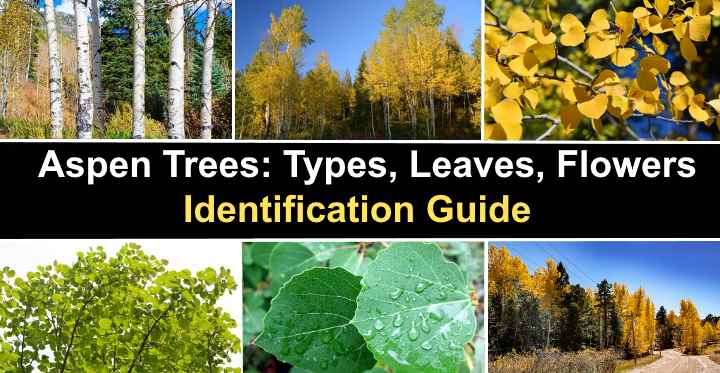
Aspen trees are medium-sized deciduous trees with rough gray-white bark and large round leaves with toothed margins. The quaking aspen (Populus tremuloides) and bigtooth aspen (Populus grandidentata) are the most common aspen trees in North America. Aspen trees have a unique spreading root system that produces new clone trees. You can find aspens growing as far north as Alaska and as far south as Mexico.
The quaking aspen is the most widely distributed tree in the US. Quaking aspen is a tall, straight tree that has thin, rounded leaves that always rustle in even slight breezes. This action makes the aspen trees quake or tremble. The related European trembling aspen tree (Populus tremula) also has a quaking behavior.
Aspen trees typically grow among coniferous trees in North America. Aspen trees are cold-hardy trees that thrive in USDA zones 2 through 8. You will often find smaller aspen trees growing alongside large, mature aspens as the tree suckers sprout up from roots.
This article is a guide to identifying the different species of aspen trees. Descriptions and pictures of aspen leaves and bark will help to recognize aspens growing in parks or forests. This information will also help you tell aspen trees apart from birch trees.
Aspen Tree Facts
Aspen trees are flowering trees belonging to the genus Populus. Aspens are characterized by their straight, slender trunks, round leaves, and clusters of dangling flower spikes called catkins. Aspens grow between 20 and 80 ft. (6 – 24 m) tall and 20 to 30 ft. (6 – 9 m) wide.
Being a member of the Populus family, aspens are related to cottonwood trees and poplars. Some common names of the quaking aspen tree are trembling poplar, white poplar, and American aspen.
Aspens trees have fast growth rate and can increase in height around 2 ft. (60 cm) per year. The cold environment where aspens grow doesn’t affect their development.
Aspen trees live between 40 and 150 years. However, their spreading rhizome root system can live for thousands of years. As older, mature trees die, suckers sprout, and new trees grow.
Aspen Tree Leaves
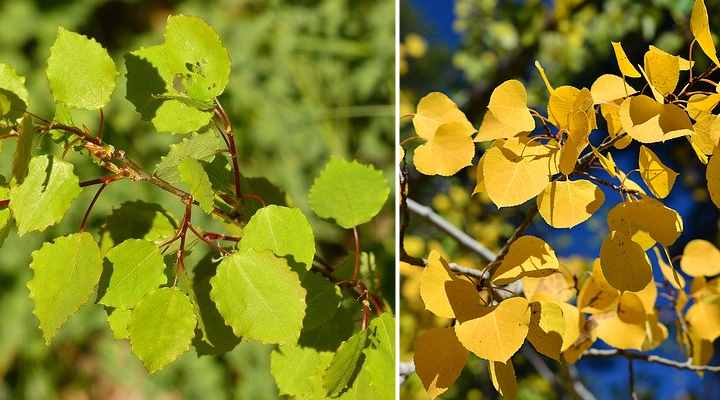
Aspen tree leaves and autumn foliage on the right
Aspen leaves are smooth and glossy green round leaves with a pointed tip, and grow about 1.5” to 3” (4 – 7.5 cm) across. Some aspen species have oval leaves with toothed or slightly lobed margins. The rounded aspen leaves attach to branches by flattened stems (petioles). In the fall, aspen tree leaves turn spectacular golden yellow, orange or bronzy-red.
The quaking appearance and rustling noise of aspen trees are due to the leaves. The short, flattened stems are attached at right angles to the flat leaf. The growth habit causes even in the slightest of breezes to make aspens quake. This leaf action makes a gentle, calming rustling sound.
The differences in leaf shape of native aspen trees help identify individual species. For example, the quaking aspen tree has leaf margins with fine teeth. However, the bigtooth aspen tree has larger, more spaced teeth making the leaf look jaggy.
Aspen leaves give the tree its names, such as quaking aspen, trembling aspen, or trembling poplar. Leaves on aspen trees quiver and rustle with just the slightest breeze. This effect makes aspen leaves look like thousands of fluttering butterflies.
Aspen Tree Bark
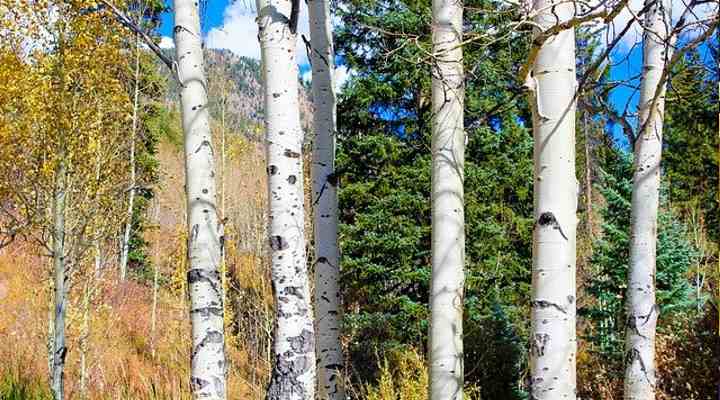
A close up picture of aspen tree trunks with smooth whitish bark and a few dark patches
Aspen tree bark is smooth and greenish-white when mature and becomes rough and fissured as the tree grows. Closeup pictures of aspen bark show that it’s relatively thin with horizontal splits and black bumpy patches. The silvery-white look of aspen trees makes them easy to mistake for white birch trees.
Aspen tree bark is unique in a few ways. First, the greenish appearance is chlorophyll, which makes aspen bark photosynthetic. Second, bark from aspen trees acts as food for butterflies, deer, beaver, moose, and elk.
Aspen Tree Trunk
Aspen trees are identifiable by their long, slender straight trunks. Measuring up to 80 ft. (24 m) tall and 8 ft (2.4 m) in diameter, aspen tree trunks are mostly branchless halfway up. The tall aspen trunks have a narrow crown that seems to flutter continuously.
Aspen Tree Roots
Aspen roots are vigorous, fast-spreading rhizomes that stretch up to 30 ft. (9 m) from the tree trunk. Aspen tree roots only grow about 1 ft. (30 cm) below the soil’s surface. This growth habit and its fast, spreading nature mean that aspen roots can damage foundations.
Aspen roots are invasive and continuously produce new growth or suckers. Even if you remove the trees, roots left in the ground continue to grow.
If planting quaking aspens trees in a garden landscape, ensure they are at least 30 ft. (9 m) away from buildings.
Aspen Seeds
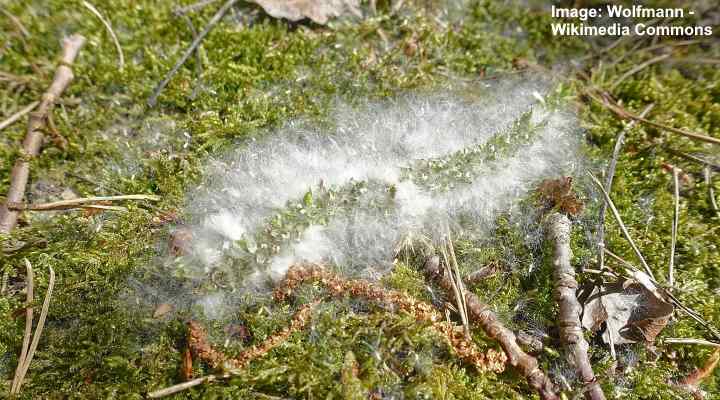
Aspen seeds
Aspen seeds look like tiny tufts of cotton wool that are blown off the trees in early summer. Aspen tree seeds appear after the aspen flowers finish flowering. The flowers and seeds grow on dangling catkins that measure up to 2” (5 cm) long.
How to Identify Aspen Tree
The aspen tree’s identifying features are its tall, slender appearance, thin round tooth-edged leaves on the ends of long stems, and grayish bark. You can recognize aspens by the fluttering leaves that make the tree look as if it’s trembling. Also, you’ll notice that aspens tend to grow in groves rather than individual trees.
Comparing the leaves from aspen trees is the way to identify individual species. For example, the bigtooth aspen tree has larger leaves and coarser toothed edges than that quaking aspen tree. However, the European aspen tree leaves have a more rounded shape.
Aspen Tree vs. Birch
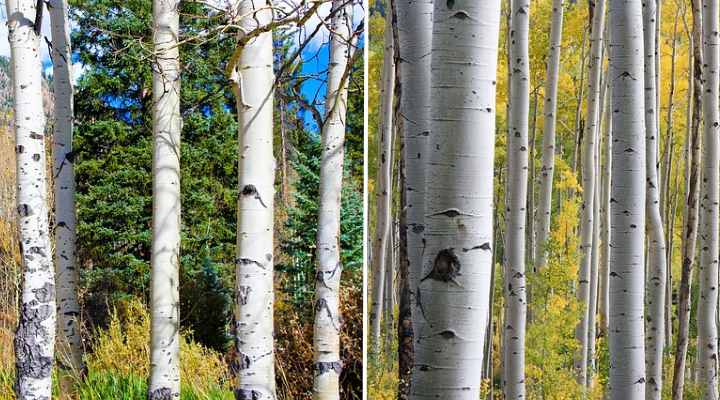
Aspen tree trunks (left) are very similar to birch trunks (right)
It’s easy to mistake aspen trees for birch trees. Although both species have long, straight whitish stems, they are from different families. Aspen is in the genus Populus and birch in the genus Betula. Other differences between aspens and birch include the type of bark and leaves.
Aspen bark becomes rough and fissured as the fast-growing tree matures. Birch tree bark is thin and papery and, unlike aspen trees, easily peels.
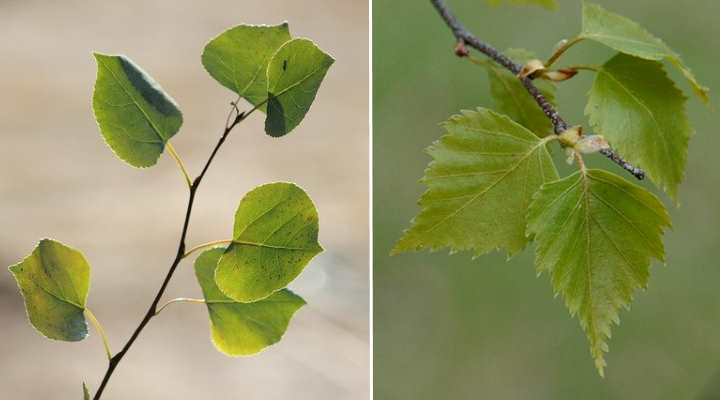
Aspen leaves (left) are usually rounder and shorter than birch leaves (right) and have less serrated edges
You can also distinguish aspen trees from birch trees by their leaves. On aspen trees, look for flat, rounded leaves with a pointed tip and serrated edge. The leaves look wider, rounder and shorter than birch leaves and are usually more finely toothed. Birch trees have lanceolate leaves that have a “V” shape, not flat like aspen leaves.
Types of Aspen Trees (with Pictures)
Let’s look in more detail at the various types of aspen trees.
Quaking Aspen Tree (Populus tremuloides)
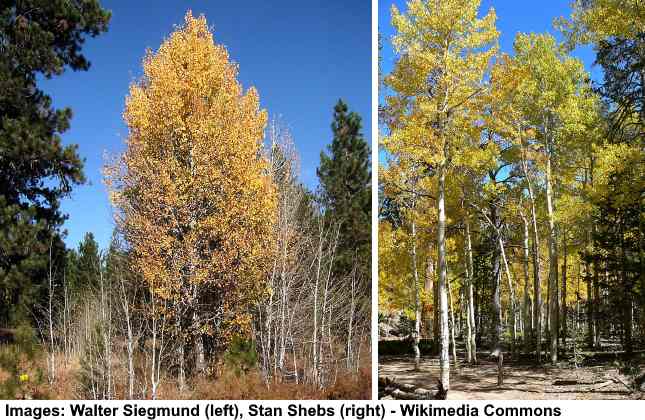
Quaking aspen trees (Populus tremuloides)
The quaking aspen tree is the main species of aspen growing in North America. Quaking aspen trees grow between 20 and 80 ft. (6 – 24 m) tall and around 20 ft. (6 m) wide. Quaking aspen trees are easy to spot due to their ‘trembling’ leaves that continuously flutter and create a rustling noise.
Like all aspens, the quaking aspen tree has a long, slender whitish trunk with black blotches. Rounded shiny green leaves dangling from long petioles form a rounded crown. From a distance, quaking aspen tree foliage has a pyramidal growth habit.
Due to its shimmering foliage, the American aspen or quaking aspen tree is also called trembling aspen and trembling poplar. Its stunning golden fall leaves give another name for the tree—golden aspen. It is also called the white poplar due to the gray-white bark growing on the slender trunk.
Fast-growing quaking aspen trees propagate through shallow spreading roots. New trees grow from the rhizome roots. Very soon, a mature aspen can have many smaller cloned trees growing in its vicinity. This unusual growth habit means that quaking aspens grow in groves.
The enormous root system of quaking aspens gives them the unique title of being the world’s largest plant. In southern Utah, one male quaking aspen has roots stretching over 100 acres in size. It is thought that the aspen roots of the tree weigh 14 million lb. (6 million kg). The quaking aspen is the state tree of Utah.
In residential landscapes, quaking aspens only live for about 50 years.
Aspens that tremble
The fascinating feature of Populus tremuloides is the soft rustling sound from the quivering leaves. The trembling leaf effect comes from a flattened petiole and broad round bright green leaf. Even in light, gentle breezes, quaking aspen leaves flutter. The contrast of the shiny leaf upper side and the dull underside make the aspen leaves look like butterflies.
Growing American aspen (Populus tremuloides)
The quaking aspen tree thrives in USDA zones 2 through 8. The aspen tree has a fast growth rate when planted in full sun. Aspens grow best in rich, well-draining soil and should be consistently moist. It’s best to avoid planting quaking aspens near buildings due to the vigorous, invasive root system.
Quaking aspen tree leaves
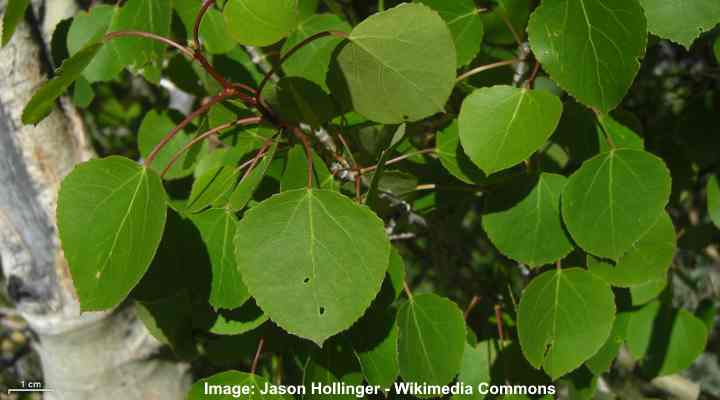
Populus tremuloides leaves
Quaking aspen leaves have a smooth, flattened appearance, circular shape, and pointed apex. The leaf’s margins have fine tooth-like serrations. Quaking aspen leaves are a bright green color that turns gold, yellow, or orange in the fall. The firm quaking aspen leaves grow up to 3” (7.5 cm) in diameter.
The golden yellow fall color of quaking aspen trees gives them a spectacular appearance. Because the trembling American aspens grow in coniferous forests, the stunning yellows and oranges contrast with the evergreen foliage of spruce, conifers, and fir trees.
Quaking aspen tree bark

Populus tremuloides bark
Quaking aspen bark is smooth and silvery-gray with a greenish tinge. As the trembling aspen matures, the bark becomes rougher. It develops with black horizontal scar-like bands and a fissured appearance. The unique feature of quaking aspen bark is its ability to photosynthesize.
Quaking aspen tree bark is an important food source for wildlife in North America. Elk, deer, and moose will strip the bark for food, leaving tell-tale vertical scars on the tree trunk.
Bigtooth Aspen Tree (Populus grandidentata)
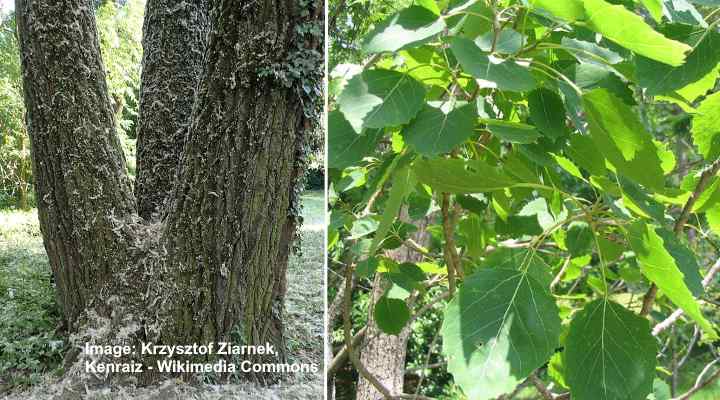
Bigtooth aspen (Populus grandidentata) tree bark of a mature tree and leaves
The bigtooth aspen tree has a large oval to ovate dull green leaves with irregular serrations along the margins. Bigtooth aspen tree trunk bark is smooth and thin with an olive-green color. The aspen bark develops a rough, dark-gray texture with deep vertical fissures.
Like the quaking aspen, the bigtooth aspen tree trembles in the slightest breeze. The aspen’s botanical name—Populus grandidentata—means “large toothed” in Latin.
Bigtooth aspen trees grow between 60 and 80 ft. (18 – 24 m) tall. You can recognize bigtooth aspens by their irregular, narrow rounded crown and straight trunks. You can tell bigtooth aspens apart from quaking aspens by their larger leaves.
Bigtooth aspens only live for between 50 and 70 years. For the first 30 years, the aspen’s tree trunk is covered with smooth bark before the rough grooves develop.
Bigtooth aspen tree leaves
Bigtooth aspen leaves grow up to 3.5” (9 cm) wide and 4” (10 cm) long. Each thin leaf blade has an ovate shape with pointed tip. Along the leaf margins are teeth that are unevenly spaced out. The bigtooth aspen leaves are dull green on the top and pale green underneath.
Bigtooth has larger leaves than the quaking aspen tree.
Bigtooth aspen leaves turn brilliant gold or yellow in the fall. Usually, this aspen species is one of the last deciduous trees to change color in the fall. This golden yellow foliage contrasts nicely beside evergreen coniferous trees.
European Aspen Tree (Populus tremula)
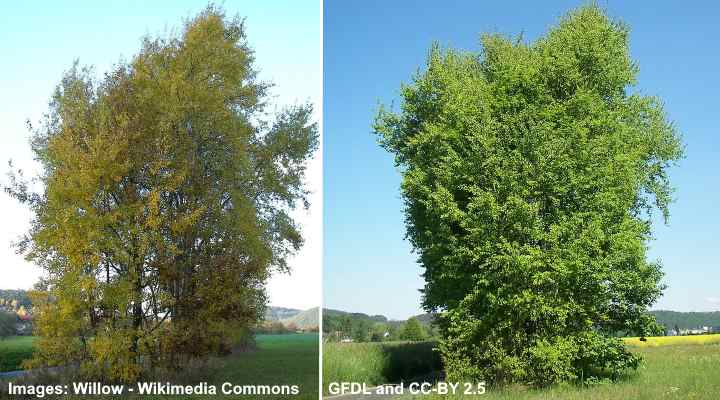
European Aspen Tree (Populus tremula)
The European aspen tree has round, flattened green leaves with a coarsely serrated margin. You can identify European aspens by their smooth pale, greenish-gray bark, broad crown, and dangling flowers on bare branches in springtime. Like the quaking aspen tree, European aspen leaves flutter and tremble in gentle breezes.
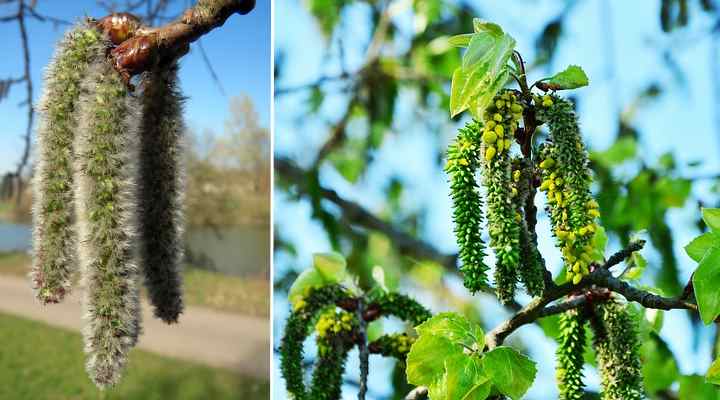
Populus tremula catkins
European aspen trees are giant Populus trees growing up to 130 ft. (40 m) tall and 33 ft. (10 m) wide.
You can tell European aspens apart from the other common aspens due to their rounded leaves that don’t have a pronounced tip. Also, the serration is coarser than quaking aspens or bigtooth aspens.
The botanical name of the European aspen also relates to its quaking habit when it’s breezy. Other names for this aspen species are common aspen, Eurasian aspen, and quaking aspen.
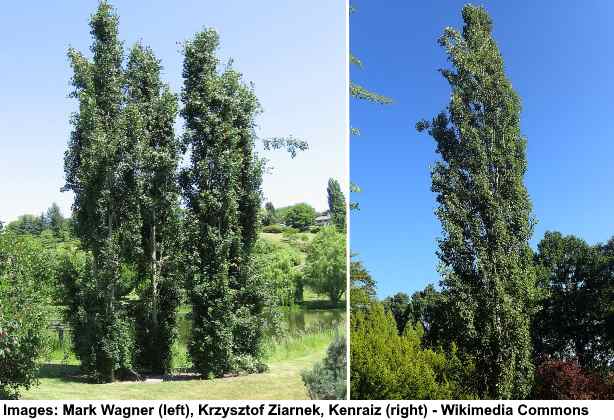
Populus tremula ‘Erecta’ is a fastigiate (columnar) cultivar of the European aspen tree
European aspen tree leaves
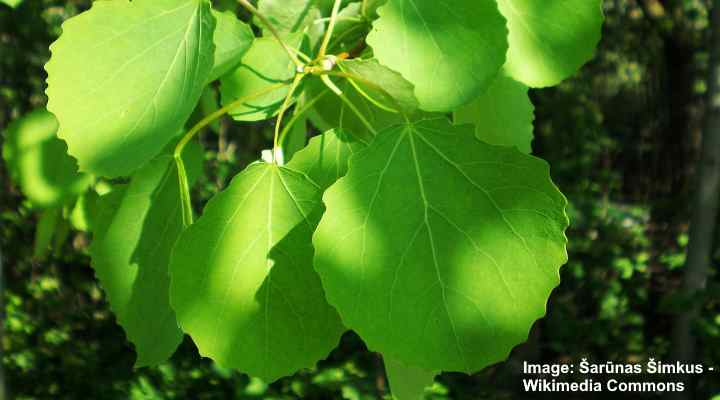
Populus tremula leaves
The leaves on European aspen trees have coarsely toothed blades with a circular shape at the end of flattened petioles. The broadleaves measure around 3” (7 cm) long. Like other types of aspen, the leaves dance and flutter in gentle breezes making a rustling noise.
European aspen tree leaves are green before turning a vibrant yellow or orange-red in the fall.
Chinese Aspen Tree (Populus adenopoda)
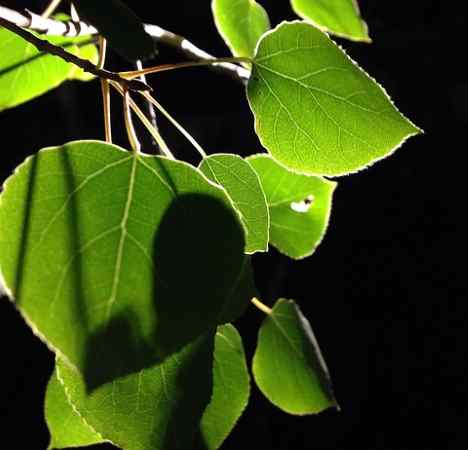
Chinese aspen (Populus adenopoda) leaves
The Chinese aspen tree is a medium to large deciduous flowering tree with smooth, grayish-white bark and smooth, ovate leaves. This aspen species grows up to 100 ft. (30 m). Like many aspens, the Chinese aspen bark becomes gray, rough, and fissured as the tree matures.
As its common name suggests, the Populus adenopoda is native to China. There, the aspen grows in mountainous regions.
Chinese aspen tree leaves
The Chinese aspen leaves are a flattened, orbicular, or ovate shape with a shiny green finish. There is fine serration along the round leaf margins; however, some species have lanceolate leaves with smooth edges. The dark green aspen leaves turn a spectacular golden yellow in the fall.
Korean Aspen Tree (Populus davidiana)
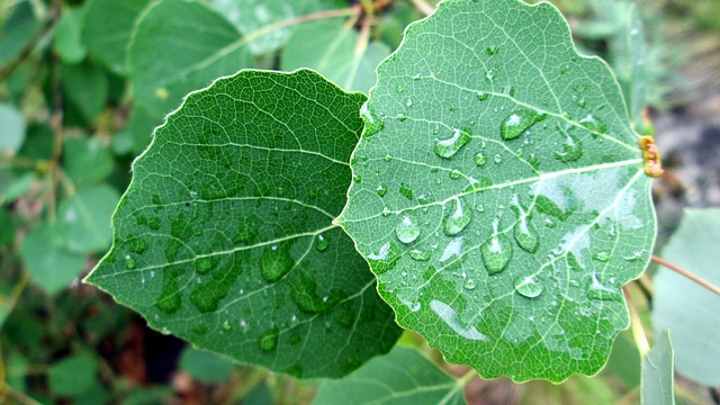
Korean aspen (Populus davidiana) leaves
The Korean aspen tree is native to Asia and has green orbicular-shaped leaves and smooth, grayish-white bark. The lush foliage forms a rounded crown on the aspen tree. Long dangling flowers appear before the leaves, and then tiny cottony seeds appear in early summer. Korean aspen trees grow up to 82 ft. (25 m) tall.
Korean aspen tree leaves
Leaves on Korean aspen trees have a broadly rounded base and a thin, pointed tip. The aspen leaves are red when immature, then turn green before becoming golden yellow in the fall. Like all aspen tree leaves, their rounded blades have finely-serrated margins.
Japanese Aspen Tree (Populus sieboldii)

Japanese Aspen Tree (Populus sieboldii) and leaves
The Japanese aspen tree grows at a fast rate and eventually reaches 65 ft. (20 m). The features of the Populus sieboldii are foliage made up of flat, rounded toothed leaves and smooth grayish-white bark.
Because of its spreading, invasive roots, it’s best not to plant Japanese aspen tree within 40 ft. (12 m) of a building. The strong aspen roots can damage foundations and sewer lines.
Related articles:
